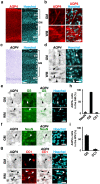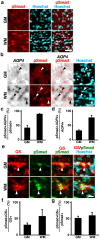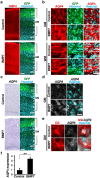BMP signaling alters aquaporin-4 expression in the mouse cerebral cortex
- PMID: 34006980
- PMCID: PMC8131757
- DOI: 10.1038/s41598-021-89997-5
BMP signaling alters aquaporin-4 expression in the mouse cerebral cortex
Abstract
Aquaporin-4 (AQP4) is a predominant water channel expressed in astrocytes in the mammalian brain. AQP4 is crucial for the regulation of homeostatic water movement across the blood-brain barrier (BBB). Although the molecular mechanisms regulating AQP4 levels in the cerebral cortex under pathological conditions have been intensively investigated, those under normal physiological conditions are not fully understood. Here we demonstrate that AQP4 is selectively expressed in astrocytes in the mouse cerebral cortex during development. BMP signaling was preferentially activated in AQP4-positive astrocytes. Furthermore, activation of BMP signaling by in utero electroporation markedly increased AQP4 levels in the cerebral cortex, and inhibition of BMP signaling strongly suppressed them. These results indicate that BMP signaling alters AQP4 levels in the mouse cerebral cortex during development.
Conflict of interest statement
The authors declare no competing interests.
Figures




Similar articles
-
Apelin-13 Protects against Ischemic Blood-Brain Barrier Damage through the Effects of Aquaporin-4.Cerebrovasc Dis. 2017;44(1-2):10-25. doi: 10.1159/000460261. Epub 2017 Apr 13. Cerebrovasc Dis. 2017. PMID: 28402976
-
GLP-1 receptor signaling restores aquaporin 4 subcellular polarization in reactive astrocytes and promotes amyloid β clearance in a mouse model of Alzheimer's disease.Biochem Biophys Res Commun. 2024 Dec 31;741:151016. doi: 10.1016/j.bbrc.2024.151016. Epub 2024 Nov 19. Biochem Biophys Res Commun. 2024. PMID: 39577079
-
Involvement of mitogen-activated protein kinase pathways in expression of the water channel protein aquaporin-4 after ischemia in rat cortical astrocytes.J Neurotrauma. 2012 Sep 20;29(14):2404-12. doi: 10.1089/neu.2012.2430. Epub 2012 Jul 10. J Neurotrauma. 2012. PMID: 22676888 Free PMC article.
-
Regulation and Function of AQP4 in the Central Nervous System.Neurochem Res. 2015 Dec;40(12):2615-27. doi: 10.1007/s11064-015-1519-z. Epub 2015 Jan 29. Neurochem Res. 2015. PMID: 25630715 Review.
-
Neuroimmunological Implications of AQP4 in Astrocytes.Int J Mol Sci. 2016 Aug 10;17(8):1306. doi: 10.3390/ijms17081306. Int J Mol Sci. 2016. PMID: 27517922 Free PMC article. Review.
Cited by
-
Canonical Bone Morphogenetic Protein Signaling Regulates Expression of Aquaporin-4 and Its Anchoring Complex in Mouse Astrocytes.Front Cell Neurosci. 2022 Apr 20;16:878154. doi: 10.3389/fncel.2022.878154. eCollection 2022. Front Cell Neurosci. 2022. PMID: 35518645 Free PMC article.
-
Aquaporins in Cardiovascular System.Adv Exp Med Biol. 2023;1398:125-135. doi: 10.1007/978-981-19-7415-1_8. Adv Exp Med Biol. 2023. PMID: 36717490
-
Evolutionary changes leading to efficient glymphatic circulation in the mammalian brain.Nat Commun. 2024 Dec 4;15(1):10048. doi: 10.1038/s41467-024-54372-1. Nat Commun. 2024. PMID: 39632840 Free PMC article.
References
Publication types
MeSH terms
Substances
LinkOut - more resources
Full Text Sources
Other Literature Sources

